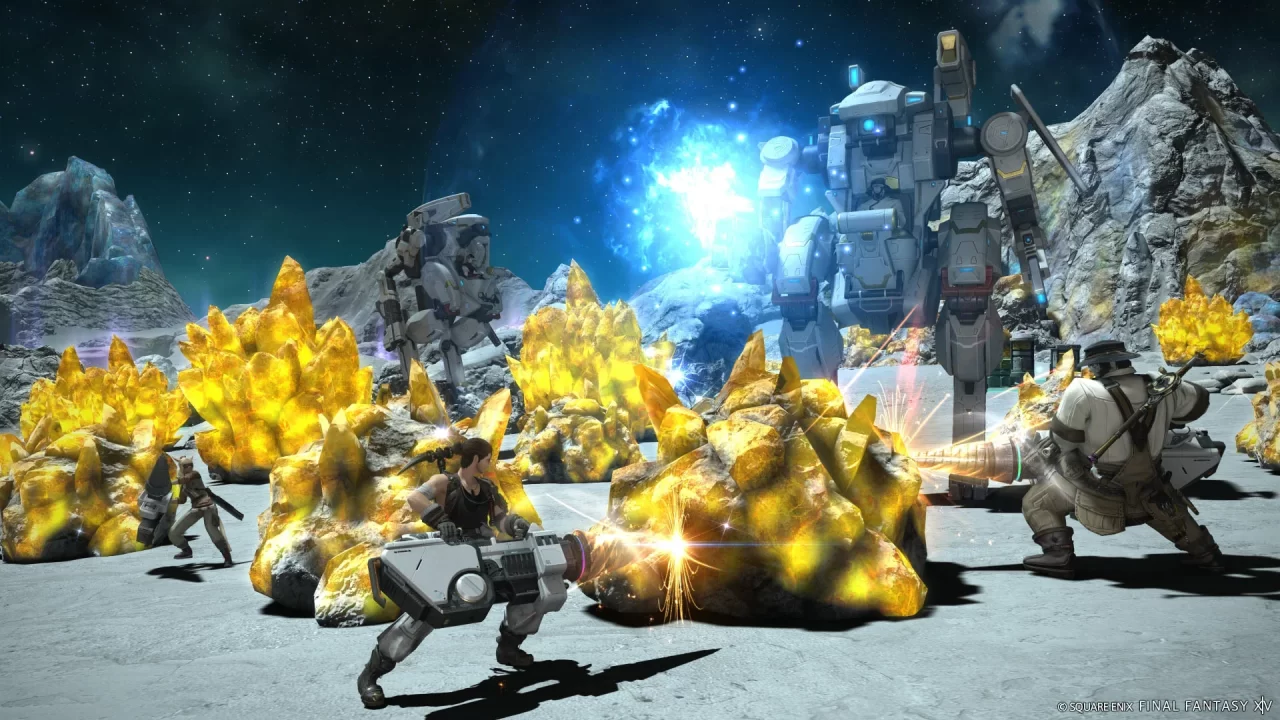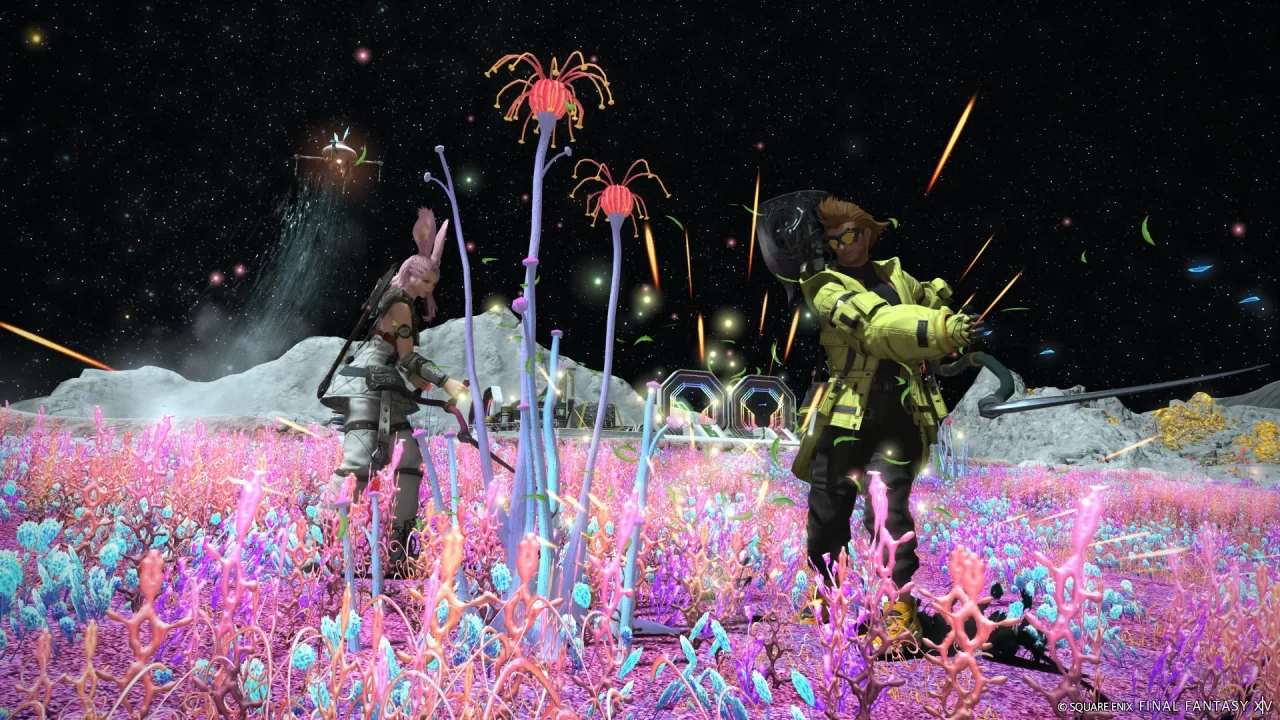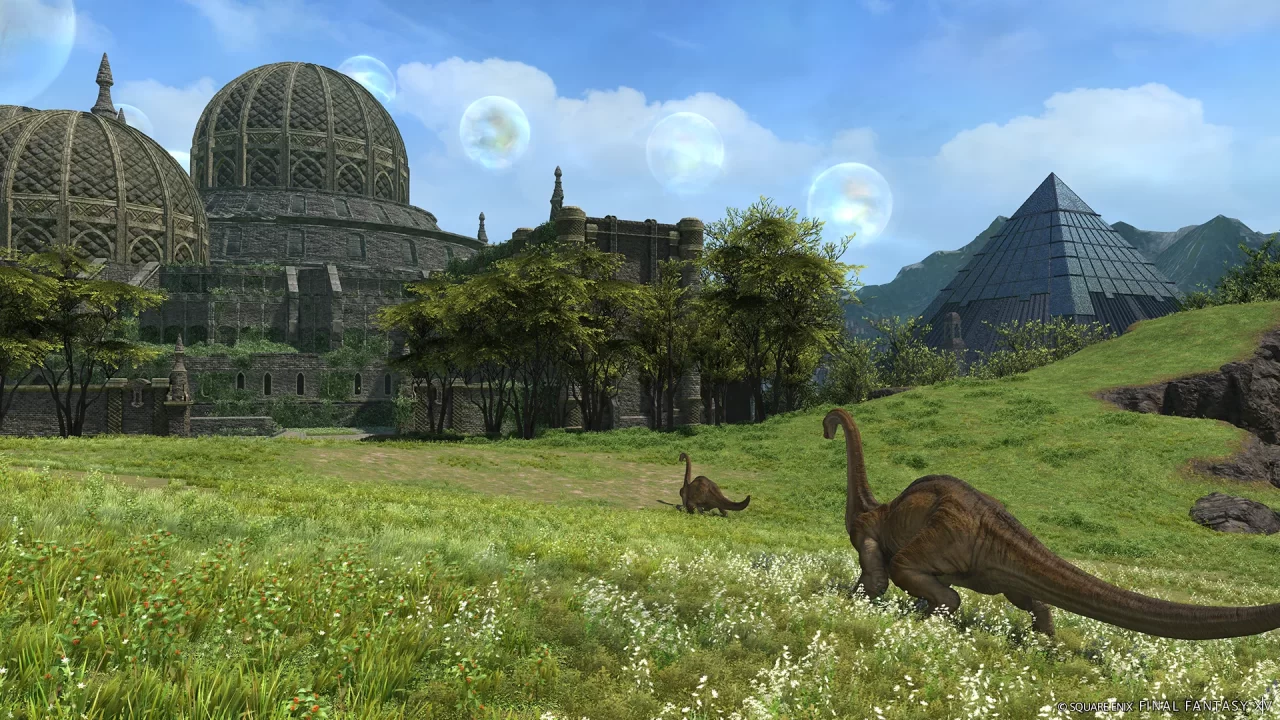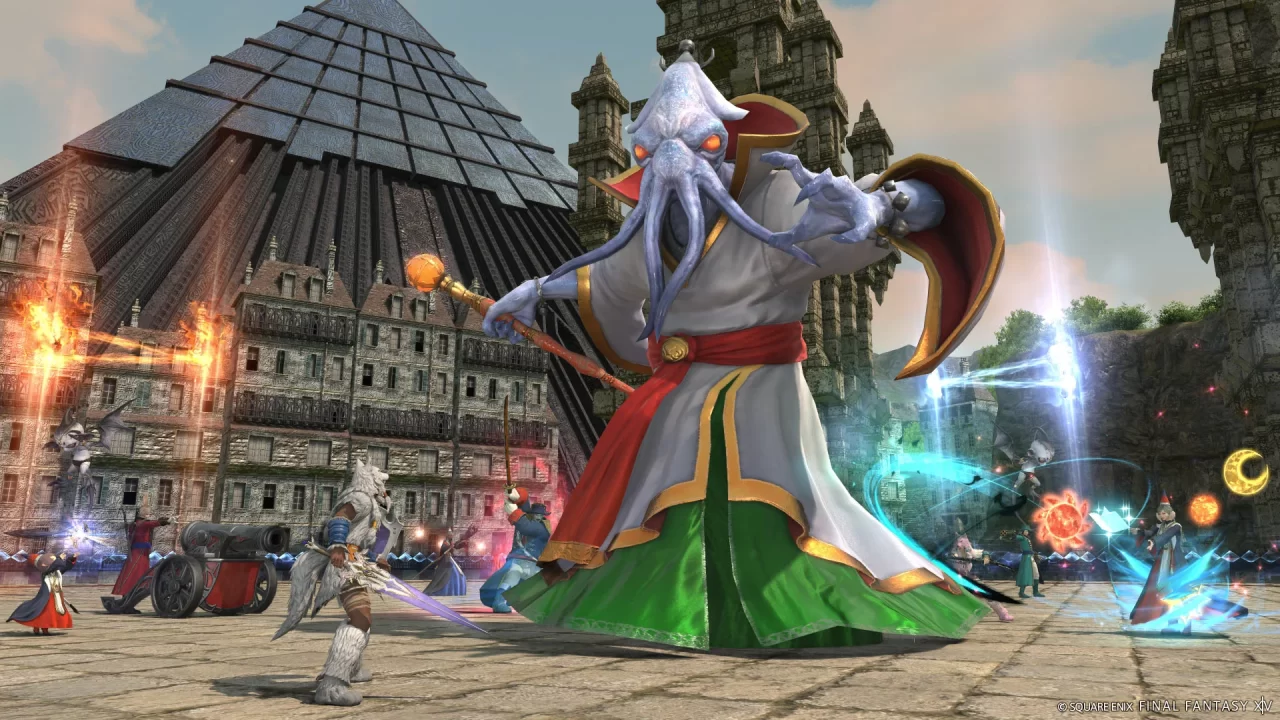Heavensward, Final Fantasy XIV’s first expansion, introduced the first iteration of field content: a huge zone where large numbers of players can explore and engage in activities together. Initially, this content was limited to battle jobs with Heavensward’s Diadem and Stormblood’s Eureka. Shadowbringers, however, created lifestyle content called Ishgard Restoration to extend the experience to crafters and gatherers, while also providing the Bozja field content for battle jobs. Final Fantasy XIV: Endwalker was a bit of a departure from the trend, as it had no field content and its lifestyle content — Island Sanctuary — was a much smaller-scale, Stardew Valley-lite experience. So it’s been quite some time since we’ve had new massive zones to run around in, and players have been eagerly awaiting Dawntrail’s promised additions ever since Yoshi-P and co. announced them at Fan Fest 2023. But has the wait been worth it?
Let’s start with Cosmic Exploration, which debuted in Patch 7.21 for crafters and gatherers. The Warrior of Light meets a Loporrit known as Namingway and gets swept up in a new venture his brethren have cooked up to explore the stars: the Cosmic Exploration Initiative. The first step of this project is to build a base of operations on the moon to launch a ship from, and as an artisan of some repute, Namingway asks the Warrior of Light to lend their expertise.
This takes the form of completing various Stellar Missions on any of the crafter or gatherer jobs players have at level 10 or above. Each job has a variety of missions to choose from, divided into different ranks that correspond to level and difficulty. Crafters are tasked with making things, while gatherers venture out into a large, new lunar zone to collect materials. The objectives for these missions can vary and introduce a certain level of challenge, regardless of the player’s current level. This adds a little variety to the experience, which is nice because you will inevitably be repeating these missions as you unlock higher ranks.
In addition to Stellar Missions, there are also Mech Ops. These are basically FATEs where everyone in the zone can participate in a mass gathering exercise. Players can purchase a license to have a chance to pilot a mech in these FATEs, and this gives the chosen players a cool mount to ride and use unique actions to complete the objective. Getting selected for mech duty is a lot of fun the first time and confers extra bonuses. But there are only two of these operations available at present, so once you do each, they get a little old.
The other major activity you can participate in is called a Red Alert. This is a short 20-minute window triggered by specific weather conditions where a small selection of jobs can complete critical missions to earn improved rewards. Players can repeat these missions as often as they can manage within the Red Alert, and if enough players contribute before time is up, everyone gets a bonus on top of mission rewards. This can be an extremely lucrative way to not only level jobs but also gather the currencies and relic experience that are unique to Cosmic Exploration.
Speaking of relics, they’re called Cosmic Tools this time around, and they represent an interesting departure from past relics. Instead of gathering and crafting items to improve your tools, you gain research data (basically experience points) with every mission you complete. Once you reach certain thresholds, you can have your tools upgraded to a new level, and this not only improves their stats but also confers currency bonuses in Cosmic Exploration zones when you have the tools equipped. Time will tell how well this new system works in the long run, but I found myself appreciating both its simplicity and how it ties relic progression into the larger lifestyle content.
As much as I like what Cosmic Exploration offers, it doesn’t feel like Square Enix fully learned their lesson from the flaws of Ishgard Restoration. Server progression has still been problematic, despite the content only being accessible on a player’s home world this time around. On patch day, the highly populated worlds all zoomed through every available upgrade within hours of servers going up, while low-population worlds struggled to get anywhere. If you missed out on the upgrades because you’re not an early bird or have a day job, you can at least watch the cutscenes via an in-game menu, but this is an unsatisfying half measure. The upgrade events are also mechanically identical to those in Ishgard Restoration — hope you like clicking the same three spots over and over — and if you don’t have enough people to complete them, they can be a mind-numbing way to waste a half hour.
Other issues, such as mounts being prohibited and certain missions feeling unusually punishing, are set to be addressed in Patch 7.3. It remains to be seen how well these adjustments will address some of the more minor quibbles I have with the content, so let’s just say that I am adopting a wait-and-see approach at this point.
Moving on to battle classes, Patch 7.25 introduced Occult Crescent. The story sees the Warrior of Light join the explorer Ketenramm on a dangerous ocean voyage to the Shades’ Triangle (which is exactly the reference you think it is). Upon arriving on a crescent-shaped isle at the center of this Triangle, the expedition quickly learns that powerful magics are responsible for the area’s treacherous reputation and odd appearance. As an insatiable adventurer, the Warrior of Light sets out to explore the island and find answers. Unfortunately, the interesting setup devolves into a series of fetch quests, each of which ends with a character spouting information at you. It’s a dull way to present the story, and you end up feeling like not much has happened by the time you finish everything.
Thankfully, the activities in Occult Crescent are a little more engaging than the story. First, the area itself is lush and full of interesting architecture that’s fun to explore, making it a vast improvement over the boring brown and grey locales from Bozja. Second, there are no hard limits on your ability to explore the island and participate in FATEs or Critical Engagements. Higher-level enemies will, of course, pose a risk if you wander too close, but with some caution (and luck) you can go pretty much anywhere from the start.
Third, while the primary leveling system is similar to Bozja and Eureka (this time, you gain Knowledge levels, and yes, you can still lose experience), the sub-action system is now a full-on sub-job system. Instead of unlocking and equipping specific actions, you can now equip one of thirteen Phantom Jobs. As you level a job, you gain access to new skills and spells, which you can only use while you have that job equipped. While this means you can’t mix and match skills from different roles the way you could in Eureka and Bozja, it also means you aren’t limited to just two actions at a time. Unlocking and leveling sub-jobs is also a lot more fun and, dare I say it, RPG-like than using items to add abilities to a list. The way you obtain some of the jobs can be a little frustrating because it involves getting random drops from certain Critical Engagements, but the majority are obtained via Occult Crescent-specific currency, which is generally plentiful enough to be reasonably accessible.
The activity loop in Occult Crescent is largely the same as past field content: you run around the area killing mobs, opening treasure chests, participating in FATEs, and taking on Critical Engagements (basically larger-scale FATEs with boss-like mechanics). The CEs are fun to learn and complete, which is good because you’ll be running them a lot to gain experience and currency, acquire new Phantom Jobs, and farm demiatma for your first relic weapon.
Unfortunately, part of the reason players wind up farming CEs more than anything else is that the other content is unreliable and unrewarding. The level scaling for FATEs is so poor that most die too fast for players to reach them in time unless they happen to already be in the area. Treasure hunting is fairly dull, and the loot often doesn’t feel worth the effort. Finally, there’s no teleporting directly to CE locations this time around, which further incentivizes players to just wait for them to spawn and use the local aethernet to reach the battle zone. CEs also spawn often, which is good for grinding but also a bit of a double-edged sword in that they frequently interrupt other activities, which sort of just compounds the issue.
There’s one other major component of Occult Crescent that I need to talk about: Forked Tower. This is a 48-player alliance raid that you unlock once you’ve finished the story quests on the island, and it is simultaneously a super fun piece of content and also an incredibly frustrating example of the devs missing the mark. The main issue is that accessing the Forked Tower requires waiting for a specific weather pattern and then offering up a special item to have a chance of getting in. You can offer more of the item to increase your chances, but you are not guaranteed access. This is reminiscent of Eureka’s Baldesion Arsenal in that you could expect to go in with a group and discover that your spot has been taken (either innocently or not so innocently) by an unaffiliated player. The issue is then worsened by the fact that the raid requires decent coordination, not only to best the bosses, but also to survive the trash mobs and traps that litter the Tower’s halls. Just like Baldesion Arsenal and Bozja’s Delubrum Reginae, you need dedicated Phantom Jobs to get through most areas unscathed, and if you mess up, the Tower also features similar resurrection restrictions that make deaths and party wipes extra punishing. All of this combines to make Forked Tower very unfriendly to any players who are expecting a more casual experience.
I should mention that Square Enix is aware of these issues and has already implemented some changes, with more to come in Patch 7.3. You can now queue into Occult Crescent as a pre-formed 48-player alliance, and in 7.3, that pre-formed alliance will get the instance to themselves for a certain amount of time — presumably long enough to spawn and enter Forked Tower. These changes should make it easier for groups to reliably access the content and focus on learning the fights. But the dev team already had a proven solution that worked pretty well in Bozja: queues. Obviously, they wanted to do something different here, and I’m not saying they shouldn’t try new things. But it’s kind of ridiculous to watch them do everything under the sun to fix these problems except the one thing that would have prevented them in the first place.
So what’s the final word on Cosmic Exploration and Occult Crescent? Well, we haven’t seen everything yet, and there are planned changes in the next major patch that will affect how the content works. But right now, I’m kind of on the fence. There’s a lot that I like, but there’s also a lot that I find frustrating. This has been a running theme for Final Fantasy XIV: Dawntrail in general, so I guess I’m ultimately not that surprised. Hopefully, future updates address my frustrations, but that remains to be seen. For now, both Cosmic Exploration and Occult Crescent are definitely worth checking out, but my recommendation is a cautious one.






